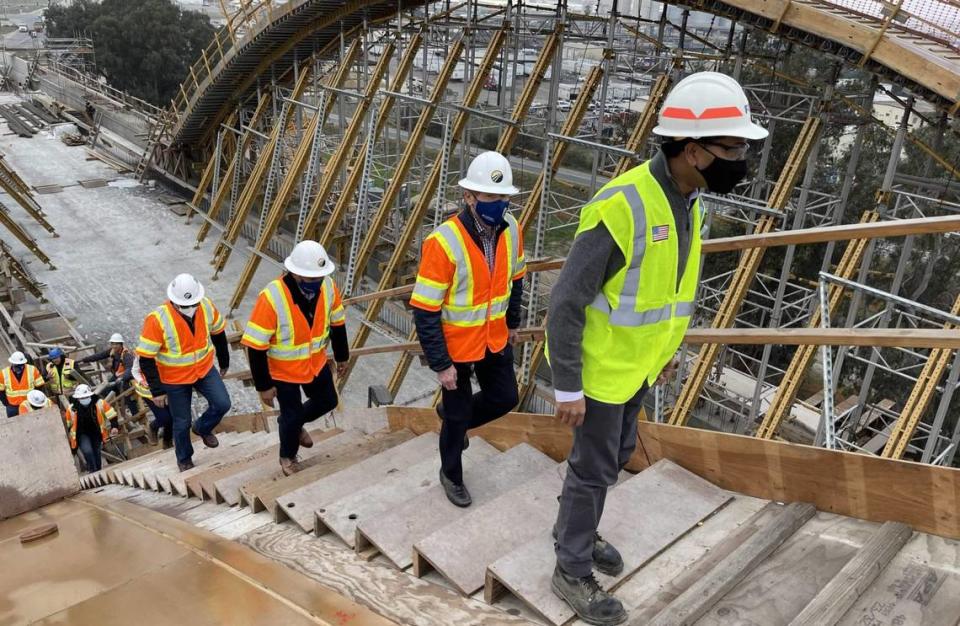California’s high-speed rail project still needs to purchase hundreds of pieces of land
The California High-Speed Rail Authority began trying to buy the land for its railroad right-of-way through the central San Joaquin Valley more than eight years ago.
The job is still not done.
As contractors hired to design and build the 119-mile stretch of the rail line in Fresno, Madera, Kings, Tulare, and Kern counties tweak their plans, the number of property parcels needed for the construction work tends to ebb and flow. Of the 2,267 pieces of property identified as needed as of late October, 1,999 had been purchased or acquired and made available to contractors.
Daniel Horgan, who serves as program administrator for the rail project under a contract with consultant WSP US, reported to the state rail authority’s board on Thursday that 268 parcels of land – almost 12% of the total – was yet to be secured and delivered to builders.
That comes after recent design changes that eliminated the need for 26 parcels, while two more were added to the list.
The pace of property acquisition is critical to progress on the embattled rail project. The first of three construction contracts in the central San Joaquin Valley, for a stretch of the route from north of Madera to south of Fresno, was awarded in 2013 but had yet to lay its hands on any of the land needed before work could begin. Subsequent contracts cover portions of the route from south of Fresno to the Tulare-Kern county line and from the Tulare-Kern line to Shafter in Kern County.
The decision to award construction contracts in the Valley before sufficient planning and land purchases had taken place was driven by a 2017 deadline for project completion that was originally contained in a federal stimulus grant agreement between the state and the Federal Railroad Administration for construction in the Valley. The federal agency later agreed to modify the agreement to require only that the money be spent by the end of September 2017 but requiring completion of the work by the end of 2022 – about a year from now.
In the years since the federal grants were awarded, the California project has encountered setbacks: construction-schedule delays, cost increases, intense opposition, including lawsuits, and growing doubts about the state rail authority’s ability to bring the effort to fruition.
The state began its efforts in 2013 to buy the property it needs for construction of the rail route through the Valley, but the progress has been painfully slow and has created corresponding delays in construction because contractors cannot build on land that the state does not yet own.
Horgan said the authority and its real-estate team have, in recent months, been averaging close to 30 parcels per month finalized and turned over to contractors. “Progress has been good, and momentum will continue to be good,” he told the rail board’s finance committee.

Financial uncertainty
Money is also a limiting factor for the project. There have been federal grants amounting to about $3.5 billion, awarded by the Obama administration in 2012 and 2013. That money has already been spent.
There’s also Proposition 1A, a $9.95 billion high-speed rail bond measure approved by California voters in 2008. There’s about $4.2 billion remaining in unspent bond funds, but earlier this year, the state Legislature rebuffed Gov. Gavin Newsom’s request to release that money to continue construction in the San Joaquin Valley. Negotiations on that request are ongoing.
“We think it is likely that through that conversation (between legislative leaders and Newsom), the scope and revenue elements will change,” Brian Kelly, the rail authority’s CEO, said Thursday. That will require the agency to revisit its financial picture next spring and summer. If the stalemate between Newsom and legislators is prolonged beyond early 2022, it could set the stage for construction delays on the already-behind-schedule project and layoffs of workers on the Valley construction segments.
Already, the rail authority has pushed back its plans to seek bids to order the first sets of electric trains for testing the tracks and electrification systems – a cost estimated at about $389 million.
That leaves money from the state’s cap-and-trade program – the rail authority’s share of funds paid by companies into California’s greenhouse gas-reduction program through auctions to buy air-pollution credits that can be applied against their own emissions of carbon dioxide.
While a precipitous dip in quarterly cap-and-trade auction proceeds in 2020 was attributed largely to the COVID-19 pandemic, the two most recent auctions in August and November have yielded the largest anticipated contributions to date from the program, said rail authority chief financial officer Brian Annis. The proceeds from the August auction for the agency are estimated at $252 million, and the November auction is expected to pitch in another $353 million.
“Our projected funding is sufficient” to continue construction in the Valley through the 2021-22 fiscal year that ends next June, Annis told the rail board.

